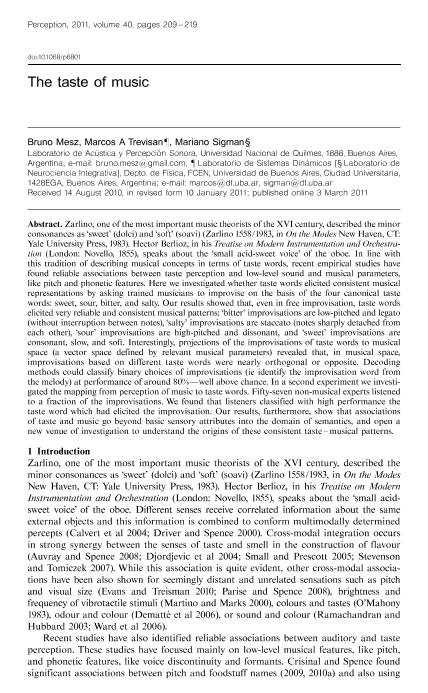Mostrar el registro sencillo del ítem
dc.contributor.author
Mesz, Bruno

dc.contributor.author
Trevisan, Marcos Alberto

dc.contributor.author
Sigman, Mariano

dc.date.available
2018-08-27T16:57:54Z
dc.date.issued
2011-03
dc.identifier.citation
Mesz, Bruno; Trevisan, Marcos Alberto; Sigman, Mariano; The taste of music; Pion Ltd; Perception; 40; 2; 3-2011; 209-219
dc.identifier.issn
0301-0066
dc.identifier.uri
http://hdl.handle.net/11336/57209
dc.description.abstract
Zarlino, one of the most important music theorists of the XVI century, described the minor consonances as 'sweet' (dolci) and 'soft' (soavi) (Zarlino 1558/1983, in On theModes New Haven, CT: Yale University Press, 1983). Hector Berlioz, in his Treatise on Modern Instrumentation and Orchestra- tion (London: Novello, 1855), speaks about the 'small acid-sweet voice' of the oboe. In line with this tradition of describing musical concepts in terms of taste words, recent empirical studies have found reliable associations between taste perception and low-level sound and musical parameters, like pitch and phonetic features. Here we investigated whether taste words elicited consistent musical representations by asking trained musicians to improvise on the basis of the four canonical taste words: sweet, sour, bitter, and salty. Our results showed that, even in free improvisation, taste words elicited very reliable and consistent musical patterns: 'bitter' improvisations are low-pitched and legato (without interruption between notes), 'salty' improvisations are staccato (notes sharply detached from each other), 'sour' improvisations are high-pitched and dissonant, and 'sweet' improvisations are consonant, slow, and soft. Interestingly, projections of the improvisations of taste words to musical space (a vector space defined by relevant musical parameters) revealed that, in musical space, improvisations based on different taste words were nearly orthogonal or opposite. Decoding methods could classify binary choices of improvisations (ie identify the improvisation word from the melody) at performance of around 80%öwell above chance. In a second experiment we investi- gated the mapping from perception of music to taste words. Fifty-seven non-musical experts listened to a fraction of the improvisations. We found that listeners classified with high performance the taste word which had elicited the improvisation. Our results, furthermore, show that associations of taste and music go beyond basic sensory attributes into the domain of semantics, and open a new venue of investigation to understand the origins of these consistent taste-musical patterns. © 2011 a Pion publication.
dc.format
application/pdf
dc.language.iso
eng
dc.publisher
Pion Ltd

dc.rights
info:eu-repo/semantics/openAccess
dc.rights.uri
https://creativecommons.org/licenses/by-nc-sa/2.5/ar/
dc.subject
Perception
dc.title
The taste of music
dc.type
info:eu-repo/semantics/article
dc.type
info:ar-repo/semantics/artículo
dc.type
info:eu-repo/semantics/publishedVersion
dc.date.updated
2018-08-23T19:08:40Z
dc.journal.volume
40
dc.journal.number
2
dc.journal.pagination
209-219
dc.journal.pais
Reino Unido

dc.journal.ciudad
Londres
dc.description.fil
Fil: Mesz, Bruno. Universidad Nacional de Quilmes; Argentina
dc.description.fil
Fil: Trevisan, Marcos Alberto. Consejo Nacional de Investigaciones Científicas y Técnicas. Oficina de Coordinación Administrativa Ciudad Universitaria. Instituto de Física de Buenos Aires. Universidad de Buenos Aires. Facultad de Ciencias Exactas y Naturales. Instituto de Física de Buenos Aires; Argentina
dc.description.fil
Fil: Sigman, Mariano. Consejo Nacional de Investigaciones Científicas y Técnicas. Oficina de Coordinación Administrativa Ciudad Universitaria. Instituto de Física de Buenos Aires. Universidad de Buenos Aires. Facultad de Ciencias Exactas y Naturales. Instituto de Física de Buenos Aires; Argentina
dc.journal.title
Perception

dc.relation.alternativeid
info:eu-repo/semantics/altIdentifier/url/http://journals.sagepub.com/doi/pdf/10.1068/p6801
dc.relation.alternativeid
info:eu-repo/semantics/altIdentifier/doi/http://dx.doi.org/10.1068/p6801
Archivos asociados
